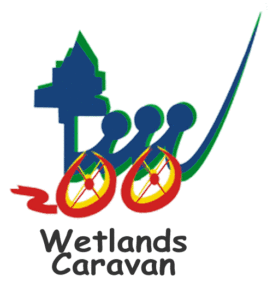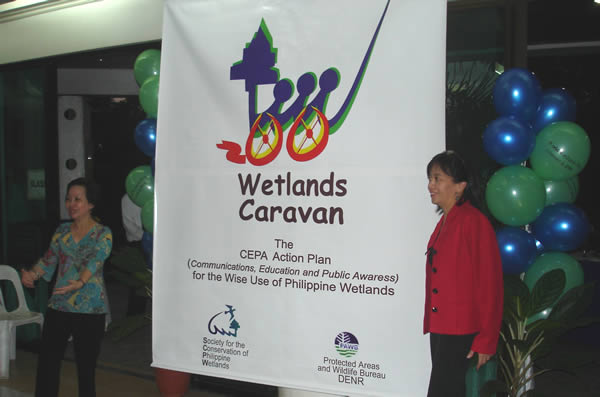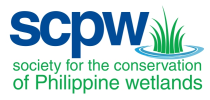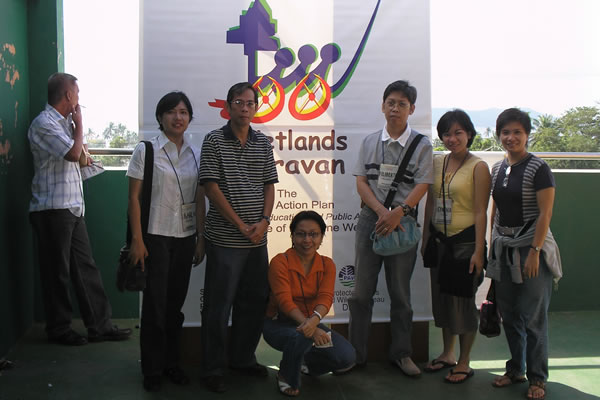Wetlands Caravan: The Evolving CEPA Action Plan
for the Wise Use of Philippine Wetlands
What is the Wetlands Caravan?
The Wetlands Caravan is the evolving national CEPA Programme of the Philippines for wetlands conservation. The Programme aims to work with the communities in achieving the Ramsar Convention’s goal of “wise use of wetlands” through localized action plans the will help catalyze change in the people’s behavior towards wetlands.

The approach of this program is to steer away from the traditional, informational approach wherein the main concern is to transfer knowledge to the local stakeholders. Instead, it will employ a more participative and community-driven approach, owing to the fact that different communities and stakeholders have their own sets of needs and uses for their wetlands.
The Program works within the framework that was crafted in a workshop on 02 February 2005 as the initial step in the CEPA formulation process. The framework identified the issues confronting wetlands in the country as well as the various key audiences and corresponding key messages. All these have been guided by the global vision as set forth in the Ramsar CEPA Programme which is “People acting for the wise use of wetlands”. The role of the community, through the Wetlands Caravan, is to set its own vision and priorities that they would want to achieve in their own locality. The community can articulate its vision by coming up with action plans directed towards the achievement of that vision.
The Wetlands Caravan is envisioned to be the strategy to translate this framework into actions or activities that will help promote the wise use of wetlands. It will be a venue to exchange information, build capacities and share best practices among different communities. It is through this dynamic interaction that the National Wetlands CEPA Action Plan will evolve – meeting the specific needs of the stakeholders, and will best address the wetland conservation issues of the country.
Wetlands Caravan Destinations
Launching of Wetlands Caravan
Wetlands Caravan for Wetlands and Agriculture
Wetlands Caravan – Laguna de Bay 2
Wetlands Caravan – Agusan Marsh
Wetlands Caravan – Candaba Wetlands
Wetlands Caravan – Island of Ticao
Wetlands Caravan – Taal Lake
Wetlands Caravan – Laguna de Bay
Wetlands Caravan – Island of Tawi-Tawi
 Approach
Approach
The Framework initially sets the vision and guiding principles that should help communities chart their specific CEPA Action Plan. It also identifies key audiences, key messages and communication medium or channels.
The idea is to bring the Wetlands Caravan to at least 20 major priority wetlands for the next five years. This means that these 20 wetlands will have prepared and/or implemented their local CEPA Action Plan by the year 2010. The Wetlands Caravan will ride on the annual theme set by Ramsar Secretariat for World Wetlands Day in setting forth activities that will trigger the preparation of the local CEPA Action Plan.
For the year that the Wetlands Caravan is being launched, the theme was “Livelihoods at Risk: In the face of poverty… wetlands are lifelines.”
Tools
Wetlands Caravan provides a selection of practical tools that can be used to aid in reviewing and planning the CEPA Activity. These tools can be adapted in different situations.
Practical Tool 1 Consequence Wheel
Practical Tool 2 Awareness-to-Action Chain
Practical Tool 3 Dartboard
Practical Tool 4 Matrix
Practical Tool 5 SWOT Analysis
Practical Tool 6 Visioning
Practical Tool 7 Stakeholder Decision Analysis
Practical Tool 8 Example Review and Action Plan Procedure and Timescale
What’s inside the Wetlands Caravan?
The Draft CEPA Framework
Vision:
People acting for the wise use of wetlands.
Goal:
To promote the wise use of wetlands in the
Philippines.
Objectives:
1. To increase the awareness and appreciation for wetlands and their many values and uses.
2. To catalyze change in the behavior of intended audiences towards wetlands.
Guiding Principles:
Wetlands provide important goods and services which help sustain human life, conserve biological diversity, and combat the impacts of climate change and desertification. Communication, education and public awareness (CEPA) are the tools for placing people’s social, political, economic and cultural realities within the context of the goods and services provide by wetland ecosystems.
- In formulating such an action plan, the aim should be to:
- Ensure that the CEPA programs are fully tailored to all local contexts (environmental, social and economic)
- Ensure that the CEPA programs respond effectively to local needs
- Adopt participatory approaches, including the fully informed involvement of local and indigenous people and their knowledge in decision-making and implementation
- Recognize the benefits of involving skilled personnel from education fields of practice
- Make full use of the existing wealth of relevant CEPA expertise located worldwide in different sectors and at different levels of social networks
- Identify new opportunities for the application of CEPA
- Develop improved CEPA approaches and techniques applicable to wetland wise use goals
It contains templates on the processes or steps to be followed when preparing a participatory local CEPA Action Plan, a very flexible template that can easily be modified according to the type of community one is working with.
Wetlands Issues and Concerns
Inside the Wetlands Caravan are discussions on the major issues and concerns confronting wetlands in the country today to make people understand the dynamics and their relationships with these important ecosystems.
Some of the major concerns include:
problems and threats: habitat destruction, overexploitation, pollution (biological and chemical), weak institutional and legal capacities
issues: biotechnology, ecotourism, domestication, bioprospecting
gaps: knowledge, management, policy

